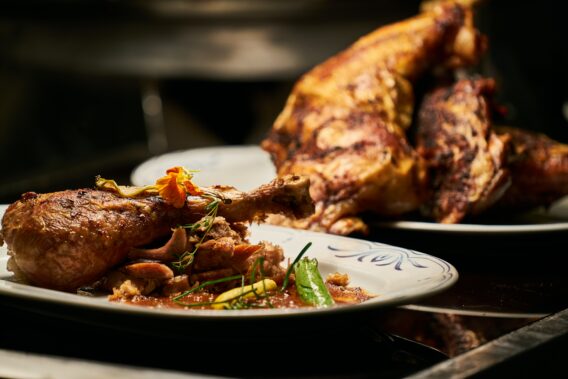Is Chicken Skin Bad for You: Pros and Cons

We all know that chicken is good for you, but what about the skin? When it comes to your chicken skin calories and general nutritional value, it boils down to how you cook it. Factors such as having a crispy chicken skin layer, and sauces used while cooking, will all play a role.
This guide will give you information on chicken skin alone (without any seasonings or sauces) so you can decide on whether you want to add or remove it from your next meal.
Pros
Taste
Leaving the skin on a chicken while you cook it will make your meat juicer and more flavorful.
Unsaturated Fats
Chicken skin contains a high amount of healthy unsaturated fat. In 1oz of chicken skin, there is a total fat content of 8.1g. This is made up of 2.3g of saturated fat, 3.4g of monounsaturated fat, and 1.7g of polyunsaturated fat. So although chicken skin has a reputation for being high in fat, most of the fat found here is the good kind – with a very small percentage of it being saturated fat.
Unsaturated fat can help lower bad cholesterol in your blood and boost good cholesterol, therefore lowering your risk of stroke and heart disease. Unsaturated fats also aid in the maintenance of your body’s brain and cell health.
Additionally, these fats can fight inflammation, and help you absorb certain vitamins like E, D, A and K.
Protein
If you are looking for ways to add extra protein to your meal then leave the skin on your chicken. For 1oz of chicken skin, you get 4g of protein.
Protein has a wide range of of benefits, some include:
- Bone health
- Building muscle and increase metabolism
- Lower blood pressure
- Helps your body repair after injury
Potassium
In 1oz of chicken skin there is 27mg of potassium.
Potassium is a mineral that is vital to many process in your body. Some benefit include:
- Maintaining a health nervous system
- Regulating muscle and heart contractions
- Reduce blood pressure
- Prevention of certain conditions such as osteoporosis and strokes
- Helps to regulate your body’s fluid balance
No Carbs
Of course, we all need carbs to survive; carbs an important part of a well balanced diet. However, if you are trying to watch your daily carbohydrate intake, than you will be pleased to know that chicken skin has no carbs.
Cons
Cholesterol
Our bodies need a small amount of blood cholesterol. Cholesterol is used to:
- Make hormones such as testosterone and estrogen
- Produce vitamin D
- Building the structure of your cell membranes
However, if you are trying to cut down on your cholesterol levels, than you might want to take the skin off your chicken – for 1oz of chicken skin there is 16.5mg of cholesterol.
Of course, chicken is not the only animal product that contains cholesterol. If you compare the amount of cholesterol in steak or bacon to chicken skin, you’ll find that chicken skin has less cholesterol.
Calories
Calories in general are definitely not a bad thing, we need them to survive. But if you are trying to eat less calories in the day, than removing the skin will lower your calorie intake from your chicken meal.
One cup of cooked chicken breast without the skin contains 231 calories, and a cup of cooked chicken breast with the skin contains 276 calories. So there’s about a 45 calorie difference.
How to Get Rid of Chicken Skin 6 Steps
If you want to make chicken for dinner and decided to get rid of the skin, there’s no need to worry, removing chicken skin is a very simple process.
- First, cut around the end of the leg bone, where there isn’t much meat. Basically tracing a circle around the joint.
2. From there you can make slits down the side of the leg, but make sure not to apply to much pressure so you don’t cut any of the actual meat.
3. Then dip your fingers in a little bit of salt to give yourself extra grip, and start peeling the skin off the leg.
4. Next make a fine cut (again remembering not to cut too deep) along the middle of the breast and peel back the skin gently.
5. Remove the wings with a pair of kitchen scissors, as this will allow you to remove the rest of the skin cleanly.
6. With the wings removed, you can peel off any remaining skin.
At the end of the day, most foods can be enjoyed in moderation. And in the case of chicken skin, adding it to your diet can have a positive effect on your nutritional intake.
Speaking of enjoying good food, the Mary Brown’s menu has a variety of delicious options for those days when you don’t want to do the cooking.